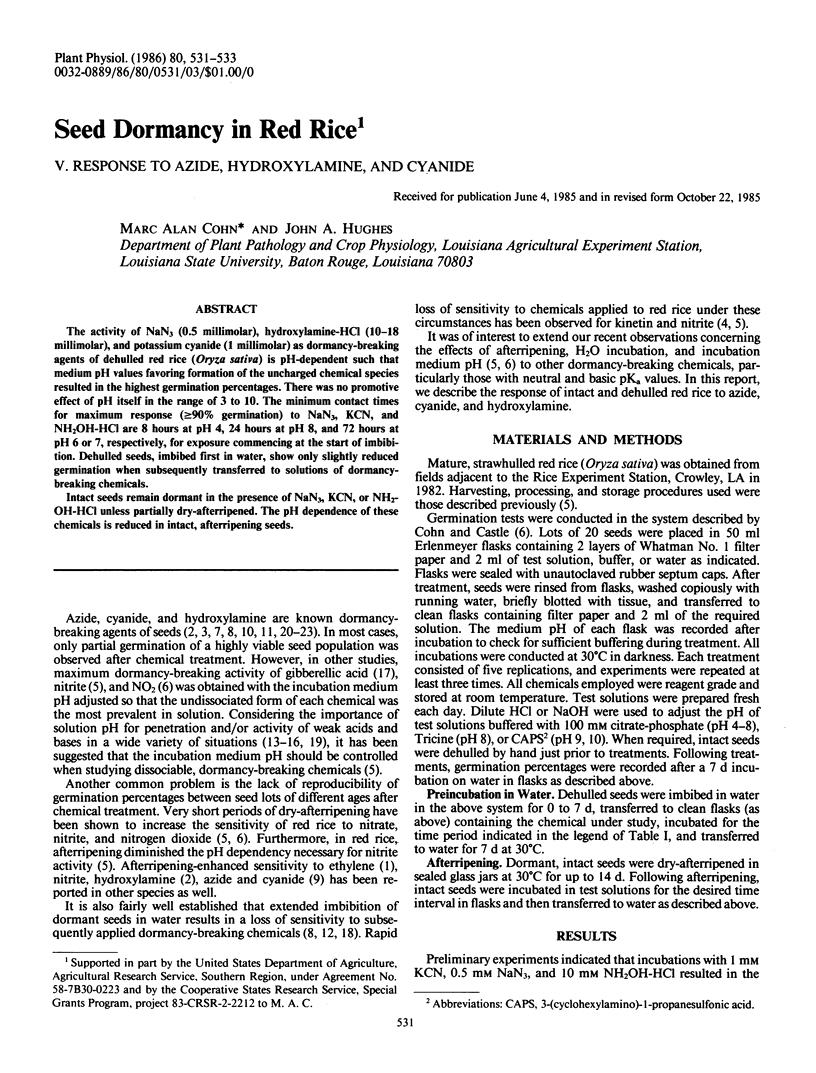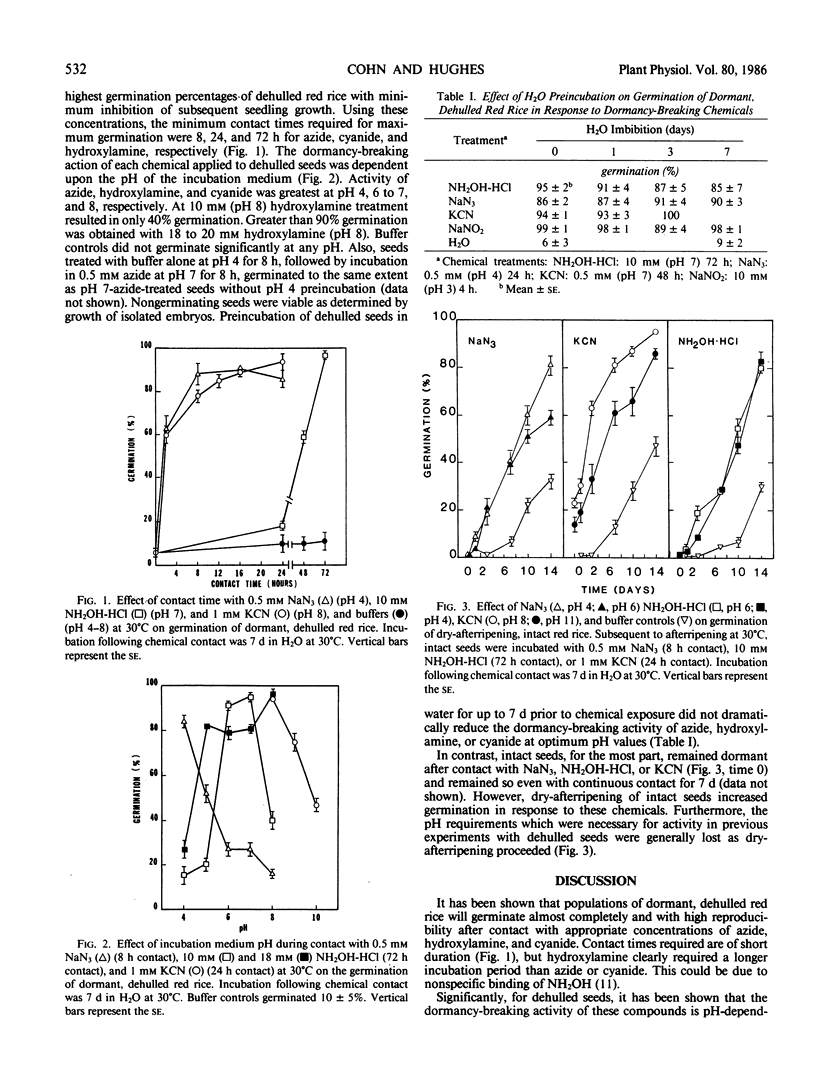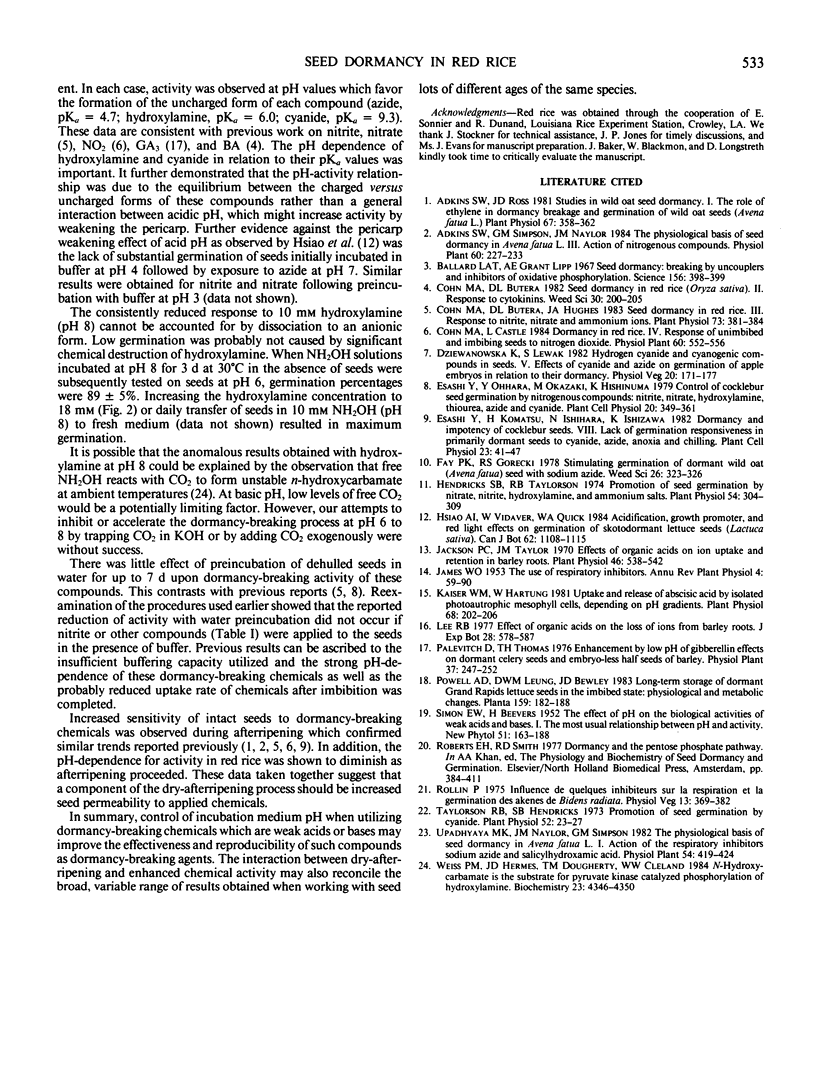Abstract
The activity of NaN3 (0.5 millimolar), hydroxylamine-HCl (10-18 millimolar), and potassium cyanide (1 millimolar) as dormancy-breaking agents of dehulled red rice (Oryza sativa) is pH-dependent such that medium pH values favoring formation of the uncharged chemical species resulted in the highest germination percentages. There was no promotive effect of pH itself in the range of 3 to 10. The minimum contact times for maximum response (≥90% germination) to NaN3, KCN, and NH2OH-HCl are 8 hours at pH 4, 24 hours at pH 8, and 72 hours at pH 6 or 7, respectively, for exposure commencing at the start of imbibition. Dehulled seeds, imbibed first in water, show only slightly reduced germination when subsequently transferred to solutions of dormancy-breaking chemicals.
Intact seeds remain dormant in the presence of NaN3, KCN, or NH2OH-HCl unless partially dry-afterripened. The pH dependence of these chemicals is reduced in intact, afterripening seeds.
Full text
PDF


Selected References
These references are in PubMed. This may not be the complete list of references from this article.
- Adkins S. W., Ross J. D. Studies in Wild Oat Seed Dormancy: I. THE ROLE OF ETHYLENE IN DORMANCY BREAKAGE AND GERMINATION OF WILD OAT SEEDS (AVENA FATUA L.). Plant Physiol. 1981 Feb;67(2):358–362. doi: 10.1104/pp.67.2.358. [DOI] [PMC free article] [PubMed] [Google Scholar]
- Ballard L. A., Lipp A. E. Seed dormancy: breaking by uncouplers and inhibitios of oxidative phosphorylation. Science. 1967 Apr 21;156(3773):398–399. doi: 10.1126/science.156.3773.398. [DOI] [PubMed] [Google Scholar]
- Cohn M. A., Butera D. L., Hughes J. A. Seed Dormancy in Red Rice : III. Response to Nitrite, Nitrate, and Ammonium Ions. Plant Physiol. 1983 Oct;73(2):381–384. doi: 10.1104/pp.73.2.381. [DOI] [PMC free article] [PubMed] [Google Scholar]
- Friesen H., Mann W. A. Follow-up study of hysterical amblyopia. Am J Ophthalmol. 1966 Dec;62(6):1106–1115. doi: 10.1016/0002-9394(66)92560-8. [DOI] [PubMed] [Google Scholar]
- Hendricks S. B., Taylorson R. B. Promotion of seed germination by nitrate, nitrite, hydroxylamine, and ammonium salts. Plant Physiol. 1974 Sep;54(3):304–309. doi: 10.1104/pp.54.3.304. [DOI] [PMC free article] [PubMed] [Google Scholar]
- Jackson P. C., Taylor J. M. Effects of organic acids on ion uptake and retention in barley roots. Plant Physiol. 1970 Oct;46(4):538–542. doi: 10.1104/pp.46.4.538. [DOI] [PMC free article] [PubMed] [Google Scholar]
- Kaiser W. M., Hartung W. Uptake and Release of Abscisic Acid by Isolated Photoautotrophic Mesophyll Cells, Depending on pH Gradients. Plant Physiol. 1981 Jul;68(1):202–206. doi: 10.1104/pp.68.1.202. [DOI] [PMC free article] [PubMed] [Google Scholar]
- Mickelson E. M., Petersons J. S., Flournoy N., Clift R. A., Thomas E. D. An estimate of the recombination frequency between the B locus and the D locus within the major histocompatibility complex. Tissue Antigens. 1976 Oct;8(4):247–252. [PubMed] [Google Scholar]
- Taylorson R. B., Hendricks S. B. Promotion of seed germination by cyanide. Plant Physiol. 1973 Jul;52(1):23–27. doi: 10.1104/pp.52.1.23. [DOI] [PMC free article] [PubMed] [Google Scholar]
- Weiss P. M., Hermes J. D., Dougherty T. M., Cleland W. W. N-hydroxycarbamate is the substrate for the pyruvate kinase catalyzed phosphorylation of hydroxylamine. Biochemistry. 1984 Sep 11;23(19):4346–4350. doi: 10.1021/bi00314a015. [DOI] [PubMed] [Google Scholar]


